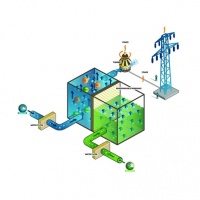Worth its salt: Norway trials osmotic power
A marine power plant that uses osmosis to generate electricity is being trialled in Norway


Anything that sounds too good to be true generally is, and, of course, there are drawbacks. Notably, the membranes that power this process have always been far too expensive to make commercial-scale power plants a practical proposition. Torleif Holt and Thor Thorsen, working for Norwegian research organisation SINTEF, began looking into this problem during the 1980s and became involved with Statkraft in 1997, aiming to develop lower-cost membranes based on electrically modified polyethylene. Funding from the European Union opened up in 2001 and finally – with a contribution from NASA (see panel) – put the technology into the realms of possibility.
The Statkraft plant uses a polyimide membrane capable of generating a watt per square metre of membrane, which requires a flow of 10 litres of water per second flowing through the membrane at a pressure of 10bar. The capacity of the plant is tiny: just 4kW. Yet, according to Statkraft, the potential for osmotic power is huge. The company claims that 1,600-1,700TWh of electricity could be generated globally each year. ’In Norway alone, we will be able to generate 12TWh per year, equivalent to 10 per cent of our total power consumption,’ it said.
Register now to continue reading
Thanks for visiting The Engineer. You’ve now reached your monthly limit of premium content. Register for free to unlock unlimited access to all of our premium content, as well as the latest technology news, industry opinion and special reports.
Benefits of registering
-
In-depth insights and coverage of key emerging trends
-
Unrestricted access to special reports throughout the year
-
Daily technology news delivered straight to your inbox










UK Enters ‘Golden Age of Nuclear’
Anybody know why it takes from 2025 to mid 2030's to build a factory-made SMR, by RR? Ten years... has there been no demonstrator either? Do RR...